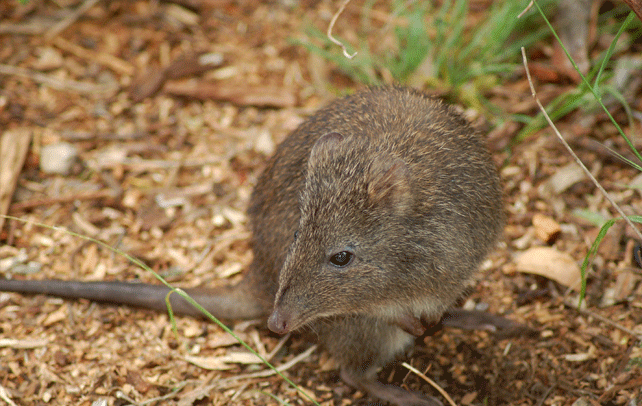Facts About Long Nosed Bandicoots

Long nosed bandicoot, an insect eating marsupial, is the largest member of the genus perameles and belongs to the family of Peramelidae. Restricted to the lands of Australia and Tasmania, these pests prefer open plains, wooded areas, clear grasslands, and drainpipes as their habitats. The physical appearance of this creature is a bit unusual with slender and elongated snout, powerful hind leg, and pouch to protect the young one. Mostly found in brown colour, the long nosed bandicoot is a nocturnal creature that feeds on insects and plants. Being nocturnal, they look for food at night and restlessly move from one place to another in order to trick the predator. Learn more about this amazing creature in the following lines.
Fast Facts
Binomial Name: Peramelesnasuta
Kingdom: Animalia
Phylum: Chordata
Class: Mammalia
Infraclass: Marsupialia
Order: Peramelemorphia
Family: Peramelidae
Genus: Perameles
Species: P. nasuta
Length: 8 to 17 inches
Weight: Around 6½ pounds
Life Span: 3 years
Range: East coast of Australia
Diet: Insects and other small invertebrates, roots, plants
Habitat: Rainforest, moist gulley, wet and dry woodlands
Age of Sexual Maturity: Males: 5 months, Females: 5 months
Gestation Period: Approx 12 days
Number of Offspring: 1 to 7, but usually 2-4
Interesting And Fun Facts About Long Nosed Bandicoots
- The Telugu language word pandikokku, which means ‘pig-rat’, was used to derive the word bandicoot. The name was used for the rodents of bandicoot genus found in India and Sri Lanka.
- The long nosed bandicoots are among those few bandicoots that make high pitched noise.
- The size of bandicoot species ranges from one foot to more than two feet.
- Among the marsupial class, the long nosed bandicoot has the highest rate of reproduction.
- They have greyish-brown colour on the back and their underside is creamy white, including parts of its feet.
- The long nosed bandicoot is nocturnal in nature and digs holes in search for food.
- They look like an interbred between a small kangaroo and a shrew to some extent.
- They are hunted by animals like dingoes, snakes, and foxes.
- After digging a hole with its paws, the long nosed bandicoot uses its elongated nose to reach in and gather the hidden insects.
- During their food search, the long nosed bandicoot makes a snuffling sound and a loud piglet-like grunting noise is made when it gets successful in catching the food.
- They defend their territory by attacking with their claws and teeth.
- Male bandicoots have large territories as compared to female ones.
- A sheltered spot in the ground covered with grass and stick forms nest for the long nosed bandicoots. The entrance of the nest is closed when in use.
- The long nosed bandicoot has a pouch in the rear which is meant to protect the young one from soil when the mother digs for food.
- Baby bandicoot stays in the pouch for at least seven weeks.
- Long nosed bandicoots are known to be solitary and they come together only to mate. They can breed at any time of the year.
- The grazing patterns of rabbits pose a threat to long nosed bandicoot’s lifestyle by making the land unsuitable for them.
- Roots, tuber, mice, and other small rodents are the common preys of long nosed bandicoots.
- After catching its prey, the bandicoot kneads it into a soft pulp, before eating.
- The aborigines, native to mainland Australia and Tasmania, hunt bandicoots for food.
- Farmers and gardeners kill them as they damage crops and gardens while digging for insects.
- Humans used to be the biggest threats and reasons for their extinction, but now these pests are protected under Australian law.
- Unlike the other bandicoots, the long nosed bandicoots are not listed as endangered species.
- The hind legs of a bandicoot that carry most of the weight are larger and stronger than the front legs.









